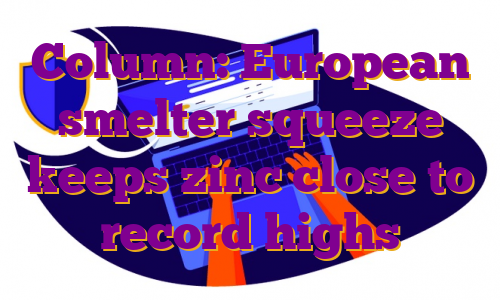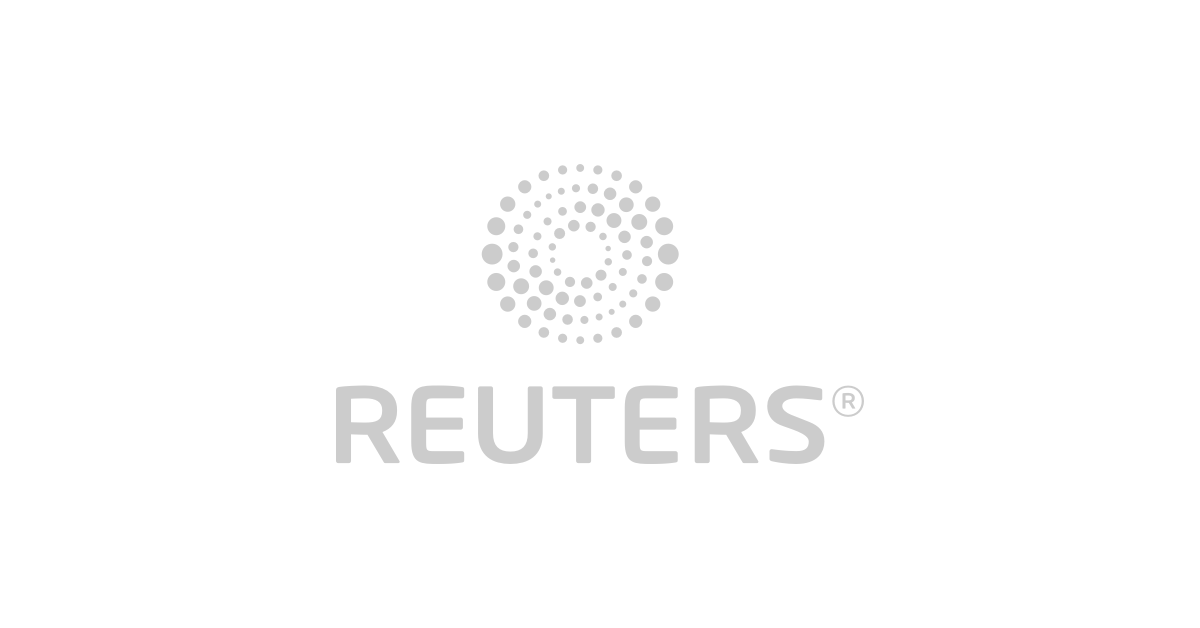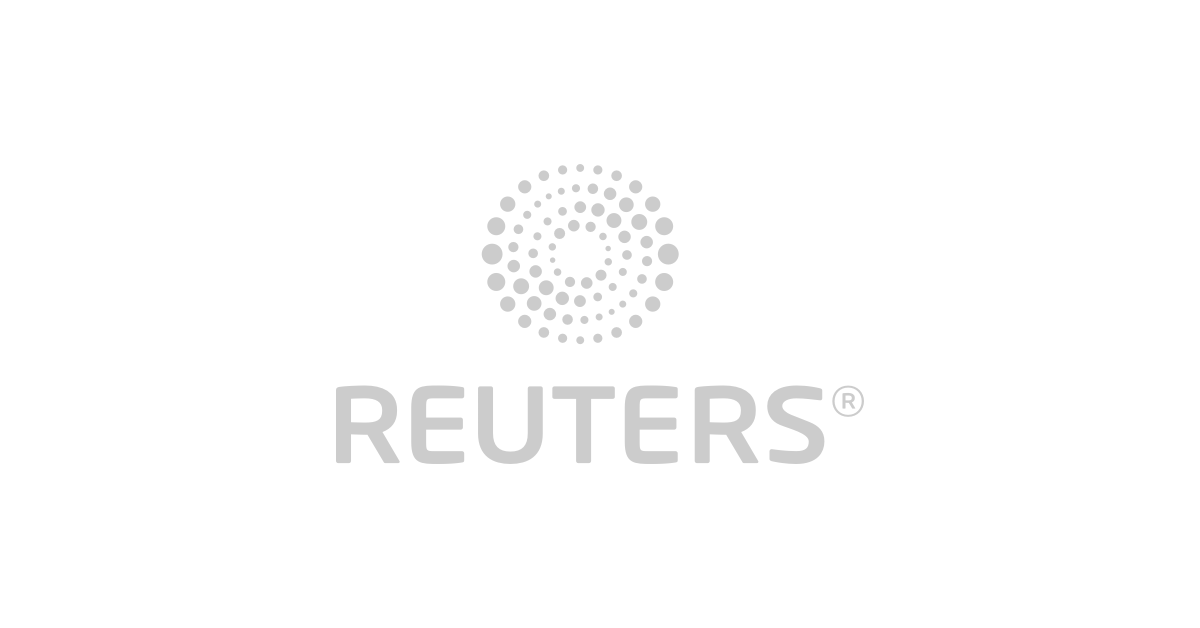LONDON, March 29 (Reuters) – London Metal Exchange (LME) zinc recorded a new all-time high of $4,896 per tonne earlier this month, eclipsing the previous 2006 peak of $4,580 per tonne.True, the March 8 spike was over in a matter of hours and looked very much like the forced close-out of positions to cover margin calls in the LME nickel contract, which was imploding at the time before being suspended.But zinc has since re-established itself above the $4,000 level, last trading at $4,100 per tonne, amid escalating supply chain tensions.Register now for FREE unlimited access to Reuters.comRussia’s invasion of Ukraine, which Moscow calls a special military operation, doesn’t have any direct impact on zinc supply as Russian exports are negligible.But the resulting increase in energy prices is piling more pressure on already struggling European smelters.European buyers are paying record physical premiums over and above record high LME prices, a tangible sign of scarcity which is now starting to spread to the North American market.The world is not yet running out of the galvanising metal but a market that even a few months ago was expected to be in comfortable supply surplus is turning out to be anything but.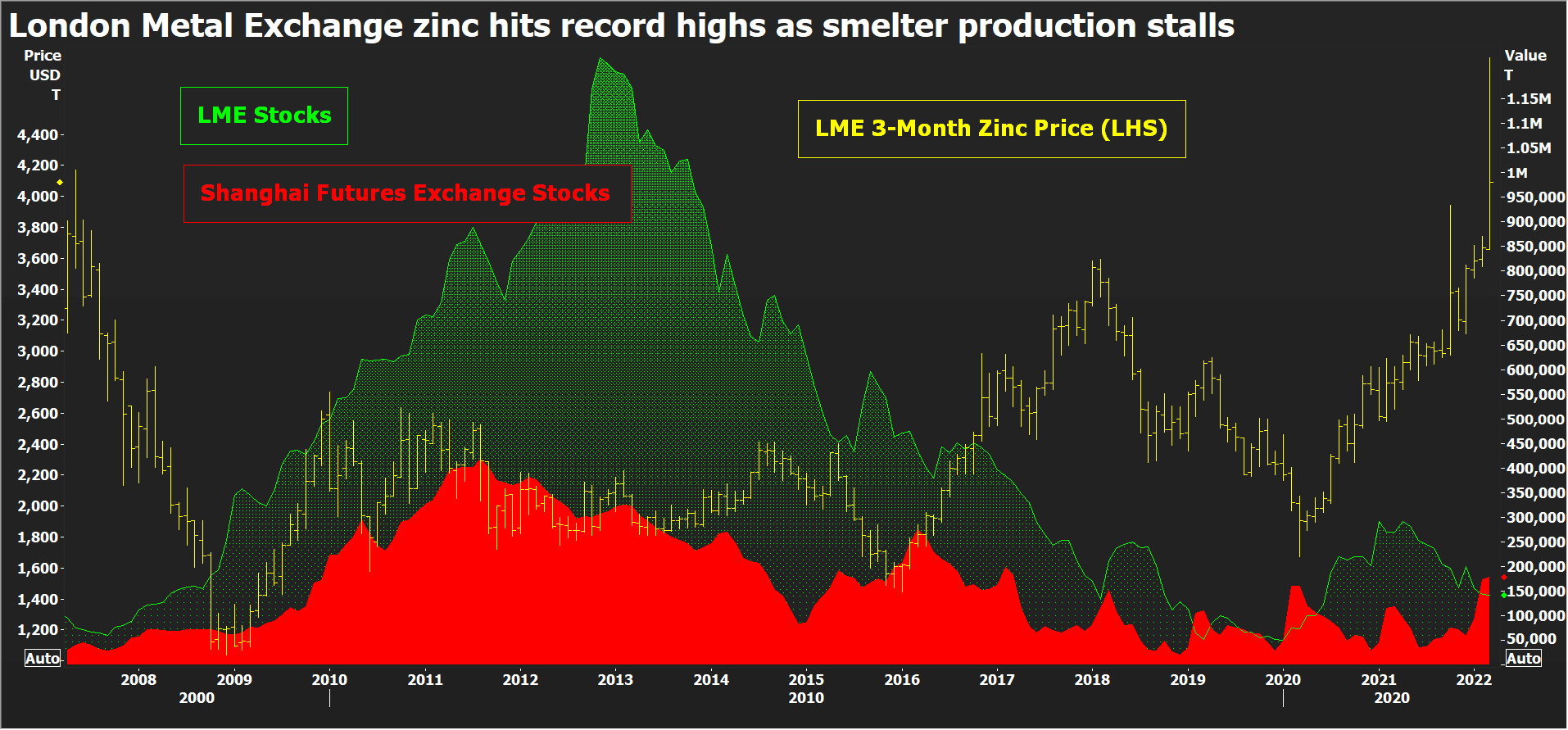 LME zinc price and stocks, Shanghai stocksEUROPEAN POWER-DOWNOne European smelter – Nyrstar’s Auby plant in France – has returned to partial production after being shuttered in January due to soaring power costs. But run-rates across the company’s three European smelters with combined annual capacity of 720,000 tonnes will continue to be flexed “with anticipated total production cuts of up to 50%”, Nyrstar said.High electricity prices across Europe mean “it is not economically feasible to operate any of our sites at full capacity”, it said.Still on full care and maintenance is Glencore’s (GLEN.L) 100,000-tonne-per-year Portovesme site in Italy, another power-crisis casualty.Zinc smelting is an energy-intensive business and these smelters were already in trouble before Russia’s invasion sent European electricity prices spiralling yet higher.Record-high physical premiums, paid on top of the LME cash price, attest to the regional shortage of metal. The premium for special-high-grade zinc at the Belgian port of Antwerp has risen to $450 per tonne from $170 last October before the winter heating crisis kicked in.The Italian premium has exploded from $215.00 to $462.50 per tonne over the same time frame, according to Fastmarkets.LME warehouses in Europe hold just 500 tonnes of zinc – all of it at the Spanish port of Bilbao and just about all of it bar 25 tonnes cancelled in preparation for physical load-out.Tightness in Europe is rippling over the Atlantic. Fastmarkets has just hiked its assessment of the U.S. Midwest physical premium by 24% to 26-30 cents per lb ($573-$661 per tonne).LME-registered stocks in the United States total a low 25,925 tonnes and available tonnage is lower still at 19,825 tonnes. This time last year New Orleans alone held almost 100,000 tonnes of zinc.
LME zinc price and stocks, Shanghai stocksEUROPEAN POWER-DOWNOne European smelter – Nyrstar’s Auby plant in France – has returned to partial production after being shuttered in January due to soaring power costs. But run-rates across the company’s three European smelters with combined annual capacity of 720,000 tonnes will continue to be flexed “with anticipated total production cuts of up to 50%”, Nyrstar said.High electricity prices across Europe mean “it is not economically feasible to operate any of our sites at full capacity”, it said.Still on full care and maintenance is Glencore’s (GLEN.L) 100,000-tonne-per-year Portovesme site in Italy, another power-crisis casualty.Zinc smelting is an energy-intensive business and these smelters were already in trouble before Russia’s invasion sent European electricity prices spiralling yet higher.Record-high physical premiums, paid on top of the LME cash price, attest to the regional shortage of metal. The premium for special-high-grade zinc at the Belgian port of Antwerp has risen to $450 per tonne from $170 last October before the winter heating crisis kicked in.The Italian premium has exploded from $215.00 to $462.50 per tonne over the same time frame, according to Fastmarkets.LME warehouses in Europe hold just 500 tonnes of zinc – all of it at the Spanish port of Bilbao and just about all of it bar 25 tonnes cancelled in preparation for physical load-out.Tightness in Europe is rippling over the Atlantic. Fastmarkets has just hiked its assessment of the U.S. Midwest physical premium by 24% to 26-30 cents per lb ($573-$661 per tonne).LME-registered stocks in the United States total a low 25,925 tonnes and available tonnage is lower still at 19,825 tonnes. This time last year New Orleans alone held almost 100,000 tonnes of zinc.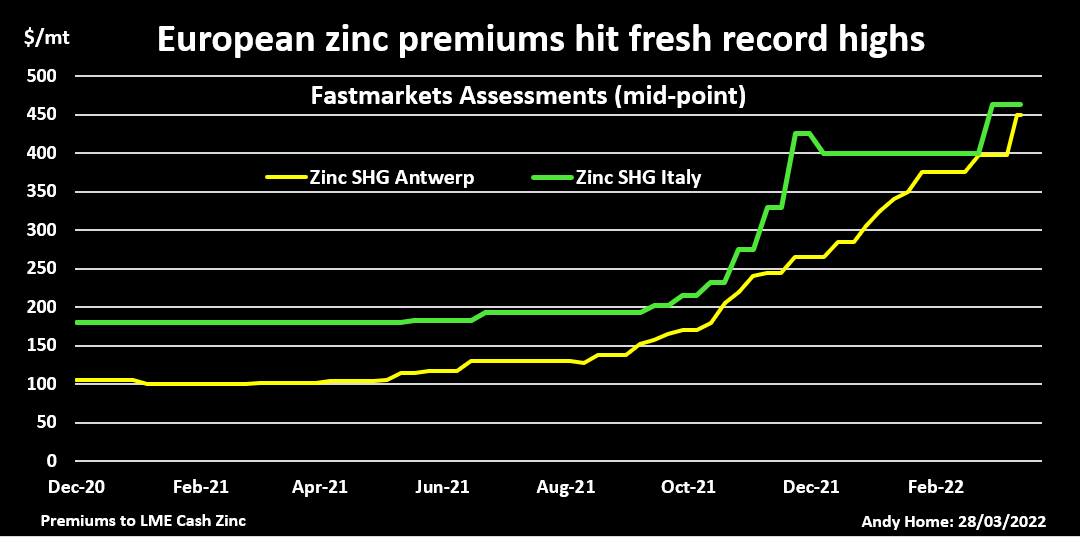 Fastmarkets Assessments of Antwerp and Italian physical zinc premiumsREBALANCING ACTAbout 80% of the LME’s registered zinc inventory is currently located at Asian locations, first and foremost Singapore, which holds 81,950 tonnes.There is also plenty of metal sitting in Shanghai Futures Exchange warehouses. Registered stocks have seen their usual seasonal Lunar New Year holiday surge, rising from 58,000 tonnes at the start of January to a current 177,826 tonnes.Quite evidently Asian buyers haven’t yet been affected by the unfolding supply crunch in Europe and there is plenty of potential for a wholesale redistribution of stocks from east to west.This is what happened last year in the lead market, China exporting its surplus to help plug gaps in the Western supply chain. Lead, however, should also serve as a warning that global rebalancing can be a slow, protracted affair due to continuing log-jams in the shipping sector.MOVING THE GLOBAL DIALWhile there is undoubted slack in the global zinc market, Europe is still big enough a refined metal producer to move the market dial.The continent accounts for around 16% of global refined output and the loss of production due to the regional energy crisis has upended the zinc market narrative.When the International Lead and Zinc Study Group (ILZSG) last met in October, it forecast a global supply surplus of 217,000 tonnes for 2021.That was already a sharp reduction from its earlier April assessment of a 353,000-tonne production overhang. The Group’s most recent calculation is that the expected surplus turned into a 194,000-tonne shortfall last year. The difference was almost wholly down to lower-than-forecast refined production growth, which came in at just 0.5% compared with an October forecast of 2.5%.With Chinese smelters recovering from their own power problems earlier in the year, the fourth-quarter deceleration was largely due to lower run-rates at Europe’s smelters.The ILZSG’s monthly statistical updates are inevitably a rear-view mirror but Europe’s production losses have continued unabated over the first quarter of 2022.Moreover, the scale of the shift higher in power pricing, not just spot but along the length of the forward curve, poses a longer-term question mark over the viability of European zinc production.A redistribution of global stocks westwards can provide some medium-term relief but zinc supply is facing a new structural challenge which is not going away any time soon.The opinions expressed here are those of the author, a columnist for Reuters.Register now for FREE unlimited access to Reuters.comEditing by David ClarkeOur Standards: The Thomson Reuters Trust Principles.Opinions expressed are those of the author. They do not reflect the views of Reuters News, which, under the Trust Principles, is committed to integrity, independence, and freedom from bias. .
Fastmarkets Assessments of Antwerp and Italian physical zinc premiumsREBALANCING ACTAbout 80% of the LME’s registered zinc inventory is currently located at Asian locations, first and foremost Singapore, which holds 81,950 tonnes.There is also plenty of metal sitting in Shanghai Futures Exchange warehouses. Registered stocks have seen their usual seasonal Lunar New Year holiday surge, rising from 58,000 tonnes at the start of January to a current 177,826 tonnes.Quite evidently Asian buyers haven’t yet been affected by the unfolding supply crunch in Europe and there is plenty of potential for a wholesale redistribution of stocks from east to west.This is what happened last year in the lead market, China exporting its surplus to help plug gaps in the Western supply chain. Lead, however, should also serve as a warning that global rebalancing can be a slow, protracted affair due to continuing log-jams in the shipping sector.MOVING THE GLOBAL DIALWhile there is undoubted slack in the global zinc market, Europe is still big enough a refined metal producer to move the market dial.The continent accounts for around 16% of global refined output and the loss of production due to the regional energy crisis has upended the zinc market narrative.When the International Lead and Zinc Study Group (ILZSG) last met in October, it forecast a global supply surplus of 217,000 tonnes for 2021.That was already a sharp reduction from its earlier April assessment of a 353,000-tonne production overhang. The Group’s most recent calculation is that the expected surplus turned into a 194,000-tonne shortfall last year. The difference was almost wholly down to lower-than-forecast refined production growth, which came in at just 0.5% compared with an October forecast of 2.5%.With Chinese smelters recovering from their own power problems earlier in the year, the fourth-quarter deceleration was largely due to lower run-rates at Europe’s smelters.The ILZSG’s monthly statistical updates are inevitably a rear-view mirror but Europe’s production losses have continued unabated over the first quarter of 2022.Moreover, the scale of the shift higher in power pricing, not just spot but along the length of the forward curve, poses a longer-term question mark over the viability of European zinc production.A redistribution of global stocks westwards can provide some medium-term relief but zinc supply is facing a new structural challenge which is not going away any time soon.The opinions expressed here are those of the author, a columnist for Reuters.Register now for FREE unlimited access to Reuters.comEditing by David ClarkeOur Standards: The Thomson Reuters Trust Principles.Opinions expressed are those of the author. They do not reflect the views of Reuters News, which, under the Trust Principles, is committed to integrity, independence, and freedom from bias. .
ستون: فشار روی با بسته شدن دومین کارخانه ذوب اروپایی بدتر می شود
لندن، 28 ژانویه (رویترز) – سال برای خریداران اروپایی روی شروع خوبی نداشته است. حق بیمه روی فیزیکی در بالاترین حد خود قرار دارد، زیرا پس از بسته شدن دومین کارخانه ذوب روی، بازار در حال تقلا برای فلز است. هزینه های برق بالا. Nyrstar کارخانه ذوب Auby خود را در فرانسه برای مراقبت و نگهداری قرار می دهد، با استناد به قیمت های "تاریخی بالای" برق اروپا که هیچ نشانه ای از کاهش نشان نمی دهد. برای دسترسی نامحدود رایگان به رویترز.com ثبت نام Glencore اکنون ثبت نام کنید. قبلاً کارخانه روی Portovesme خود را به همین دلیل تعطیل کرده است. کاهش غیرمنتظره این دو کارخانه باعث ایجاد حفره 260000 تنی در زنجیره تامین روی اروپا شده است. همچنین قیمت روی بورس فلزات لندن (LME) را گالوانیزه کرده است که خزنده است. به سمت بالاترین سطح دهه اکتبر با اسپردهای زمانی که هنوز پرتنش هستند. روی هیزیکال در آنتورپ و روتردام از اکتبر گذشته دو برابر شده و به 320 تا 380 دلار در هر تن نسبت به قیمت نقدی LME رسیده است. بر اساس گزارش Fastmarkets که ارزیابی می کند، هزینه نگهداری نقطه روی در شمال اروپا اکنون از اوج قبلی که به سال 2005 باز می گردد، فراتر رفته است. حق بیمه ها. خریداران اروپای جنوبی هنوز بیشتر می پردازند، اگرچه حق بیمه ایتالیا از افزایش بازمانده است و اکنون در 380-420 دلار در هر تن ثابت مانده است. انبارهای LME در سراسر اروپا تنها 1350 تن روی دارند که بین 1325 تن در بندر بیلبائو اسپانیا و 25 تن در بندر Vlissingen هلند تقسیم می شود. فقط 50 تن در واقع موجود است، بقیه در انتظار بارگذاری فیزیکی هستند. ذخایر ثبت شده LME در ایالات متحده بالاتر از 33000 تن است، اما این مانع از افزایش حق بیمه های محلی در همدردی با اروپا نشده است. Fastmarkets به تازگی ارزیابی خود را از حق بیمه غرب میانه برای 18-23 سنت در هر پوند به 20-24 سنت افزایش داده است. با توجه به اینکه هر دو منطقه اکنون برای واردات رقابت خواهند کرد، این یک واکنش قیمت منطقی است. فراوانی آسیایی فلز اضافی باید از آسیا بیاید. که در تضاد کامل با غرب به نظر می رسد مقدار زیادی روی ذخیره دارد. بیشتر روی موجود در انبارهای LME در بنادر آسیایی، به ویژه سنگاپور، که دارای 82050 تن است، و پورت کلانگ کره جنوبی، که دارای 30،950 تن است، قرار دارد. در چین نیز در حال افزایش است زیرا کاهش سرعت تعطیلات سال نو قمری با ضعف در بخش ساختوساز، یکی از مصرفکنندگان کلیدی روی در قالب فولاد گالوانیزه، همراه شده است. سهام بورس آتی شانگهای این هفته 23 درصد دیگر جهش کرد و به 92333 تن رسید که بالاترین سطح است. از ماه مه سال گذشته. بالقوه برای یک جریان صادراتی چینی ناشی از آربیتراژ وجود دارد تا شکاف رو به رشد زنجیره تامین غرب را پر کند. این فرآیند در شرایطی از اختلالات مداوم بندر و نرخ بالای حمل و نقل. بازار جهانی سرب بیشتر سال گذشته را بین ذخایر بالا در چین و کمبود در هر جای دیگر قطبی سپری کرد. با وجود باز بودن پنجره آربیتراژ، سرب تصفیه شده تنها در سه ماهه چهارم سال شروع به خروج از بنادر چین کرد. به بالاترین حد خود در 14 سال گذشته با کاهش ظرفیت بیشتر کارخانه ذوب اروپا. نوسانات فورچون در حالی که انتقال سهام به خارج از آسیا ممکن است به زمان نیاز داشته باشد، خریداران در هر جای دیگر در تلاش برای سنجش تصویر قیمت برق دائماً در نوسان هستند. Nyrstar قبلاً هشدار داده بود که در حال کاهش تولید در اروپای خود است. حتی قبل از اعلام Auby. مانند سایر اپراتورهای روی، احتمالاً در تلاش برای کاهش آمپر در حوالی زمانهای اوج مصرف بوده است. ارزیابی تأثیر چنین تنظیم بار در سراسر اروپا دشوار است، اما ممکن است تلفات فلزی بیشتر از آنچه در دو تعطیلی تأیید شده ذوب ذکر شده است، وجود داشته باشد. همه چیز به بازارهای لحظه ای برق بستگی دارد که نوسانات بی سابقه ای را تجربه می کنند. چشم انداز آینده قیمت برق به همان اندازه نامشخص است. همه فرض می کنند که پورتووسم و اوبی پس از خروج اروپا از زمستان و کاهش قیمت برق در ماه های گرم تابستان، باز خواهند گشت. زمستان آینده اتفاق می افتد؟ یا زمستان پس از آن؟ بحران برق اروپا مشکلات ساختاری را در ترکیب انرژی منطقه آشکار کرده است که با حرکت این بلوک در مسیر کربن زدایی حادتر می شود. موقعیت خطرناک این یک مشکل بزرگ برای کارخانه های ذوب روی اروپا است. حتی ترکیبی از به گفته Macquarie Bank، قیمت LME بالاتر و حق بیمه رکورد بالا برای جبران مقیاس افزایش هزینه برق کافی نیست. تجزیه و تحلیل هزینههای یک کارخانه ذوب در هلند نشان میدهد که در کل سال 2021 توانسته است بهطور کلی، اما نقدینگی داشته باشد. مک کواری گفت که حاشیه ها "اکنون کاملاً در قلمرو منفی قرار دارند." («روی: قیمتها و حق بیمههای بالاتر نمیتواند هزینههای انرژی بالاتر را جبران کند»، 6 ژانویه 2022) حتی اگر قیمت روی LME به 4000 دلار در هر تن افزایش یابد، یک کارخانه ذوب روی به قیمت سربهسر 157 دلار در هر مگاوات ساعت نیاز دارد. این بانک اضافه کرد که هنوز هم بسیار پایین تر از قیمت های یک ماهه و یک ساله برای هلند، ایتالیا و اسپانیا است. قیمت روی LME تقریباً در اکتبر گذشته به بالاترین سطح خود در 14 سال گذشته یعنی 3944 دلار در هر تن رسید. گلنکور و نیرستار ابتدا هشدار را در مورد افزایش هزینه های انرژی در اروپا به صدا درآوردند. کاهش متعاقب آن به سطح 3100 دلار در دسامبر به دلیل شک و تردید بازار بود که تأثیر آن بر عرضه فلز قابل توجه خواهد بود. اما ابتدا بسته شدن Portovesme و اکنون Auby چیزی باقی نمی گذارد. در مورد موقعیت هزینه خطرناک بخش ذوب روی اروپا تردید وجود دارد. به همین دلیل است که قیمت روی LME اکنون دوباره بالاتر رفته است، آخرین معامله درست بالاتر از سطح 3600 دلار است، و چرا فلزات نقدی همچنان دارای حق بیمه 25 دلاری هستند. خریداران روی در اروپا فقط می توانند امیدواریم هوای بهاری گرمتر در اوایل امسال بیاید. نظرات بیان شده در اینجا نظرات نویسنده، ستوننویس رویترز است. اکنون برای دسترسی نامحدود رایگان به رویترز.com ثبت نام کنید ثبت نام ویرایش توسط دیوید ایوانز استانداردهای ما : اصول اعتماد تامسون رویترز. .

